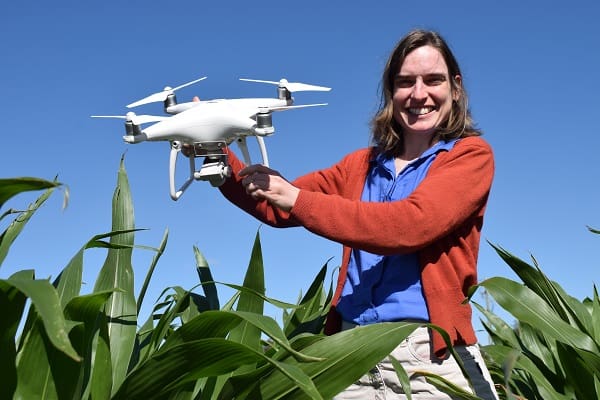The NCEA’s Dr Cheryl McCarthy is working to lift the crop imagery capabilities of drones.
ROBOTIC sensing systems with the capacity to identify weeds within a crop are being developed as part of the next advance in weed control technology.
Commercially-available weed detection sensors in Australia are currently designed for ‘green-from-brown’ situations and are not capable of discriminating between weeds and crop when they are growing next to each other.
But, as part of the next phase, the National Centre for Engineering Agriculture (NCEA), a research centre within the University of Southern Queensland, has developed a range of camera-based technologies for detecting weeds in-crop for site-specific herbicide application.
These systems have been developed for the grains, sugarcane, cotton and horticulture industries in projects since 2007, for ground-based vehicles and more recently in application to machine vision sensors on aerial drones.
The work has demonstrated that low-cost consumer-style colour cameras can be used to extract plant size, and leaf shape and texture, using deterministic algorithms to discriminate weeds from crop plants.
A system developed for the sugar industry successfully identified the leaves of Guinea Grass (a grass weed) growing amongst sugarcane (a grass crop).
In a trial in which the Guinea Grass was automatically detected and spot-sprayed in real-time from a tractor, a weed hit rate of 85 per cent with less than 1pc overspray onto crop was achieved.
Novel methods for operation in daylight without a shade hood, and real-time processing whilst travelling at up to 15-20 km/h, have been developed.
Subsequently, weed detection systems from ground-based vehicles, suitable for ‘green-from-green’ commercial field conditions in major cropping industries, are currently undergoing commercialisation.
Aerial detection
The aerial drone imagery being worked on by the NCEA provides the potential benefits of rapidly generating a weed map for a field without requiring multiple weed detection sensors to be mounted on a boom sprayer.
A trial using conventional aerial drone imagery techniques demonstrated that the extent of weed populations in a fallow field could be quickly assessed.
The technique is also potentially applicable to monitoring of plant species populations in various landscapes and for generating areas of interest for scouting on-foot.
Current research for broadacre cropping is developing technologies for an automated and real-time workflow for drone flight to prescription map generation and green-from-green spot spray operation.
The NCEA work on advanced weed sensing systems will be among the issues addressed at the 21st Australasian Weeds Conference to be held in Manly, NSW, from September 9-12.
The three-day event will cover topics on herbicide resistance and the latest research on managing problem weeds in crops.
Australasian Weeds Conference, https://www.21awc.org.au/
Grain Central: Get our free daily cropping news straight to your inbox – Click here


Hi,
We are interested in weed detection using cameras as we intend to equip a mobile robot to kill the weeds. Using a drone, we wonder how the weeds growing beside the crop and even being hidden, could be detected with drones or land running vehicle.
Best regards,
Theodor Calinescu, P.Eng.
President
TC Engineering Ltd.
Custom Machine Design & Robotics
60 St. Clair Ave. East Suite 1006
Toronto, Ontario, M4T 1N5
416-928-5941
http://www.tcengineering.ca